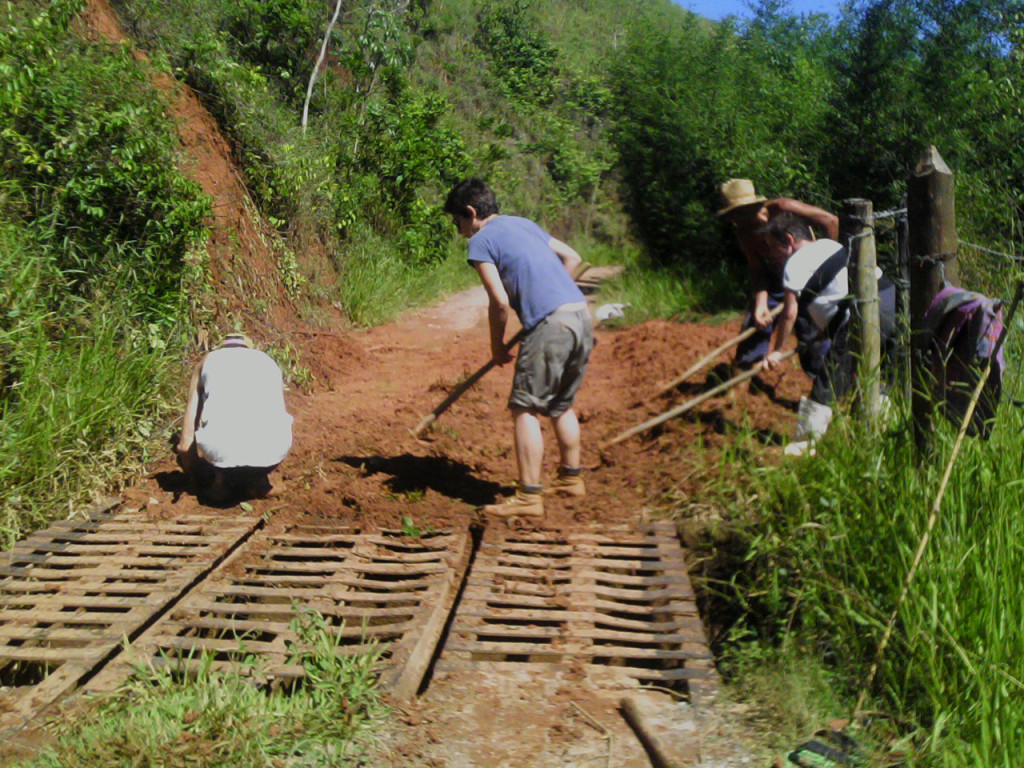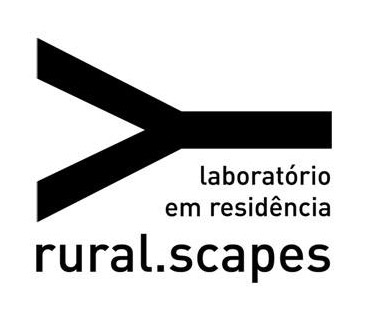selection # labRes2016_1

Juri text rural.scapes #labRes2016_1
We arrive at the Fazenda Santa Teresa in complete darkness, in the rain, from Sao Paulo, in a car driven by Toninho, a big friendly man with immense hands. We are warmly received. Awaking in the morning and opening the shutters, we discover where we are: a green valley, encircled by grassy hills, luxuriant vegetation nestling in the folds of the landscape. No other humans or buildings are in sight. A huge bamboo grove dominates the back of the house. The sound of water is omnipresent. Ducks, chickens, horses, cows and dogs wander around the house. Rural.scapes is a productive farm as well as a laboratory residence. Zé Mineiro, in charge of the day to day running of the farm, lives in a small house in front of the main building. Doña Cida reigns over the wood stove, over the place and the space.
Discover the daily rituals bit by bit. Drive to Areias, the local town. Pick up a car battery. Take it to the farm. Put it on a horse. Take it up the hill. Connect it to the solar panel. Reboot. Come down. Four times in a week. Used to thinking in the city, to existing in the city, observing all this activity just to keep the daily infrastructures like Internet working gives them much more importance and their absence creates an apparent emptiness. But actually nothing could be further from the truth. In the absence of technological abundance, and the interface of the screen, other technologies emerge, domestic and situated in the rurality, systems which enable the processing of the context and its inhabitants; and to work with the aesthetic, political, ethical and erotic conditions of its various materialities.
The situation is unusual for many, for us, the jury: the farm is both place and space. The place invites us to a now that is not so familiar to citydwellers used to the concrete jungle. The same will happen to the artists selected from the 96 projects that were received. 96 projects to read and re-read, study, investigate the authors, delve into the depth of their sites, places, centres and peripheries. The space is investigation that reveals tendencies: avoidances and confrontations of the moment. It helps to mention the place of making because it situates those who come here.
“rural.scapes is a living system where the sum of factors involved alters the connections with the place and the dynamics of work and relations. It’s a peculiar format of residency, the body continually transited by these complexities. This year 2016, for its third edition, rural.scapes has called for “projects of diverse technologies, analog and/or digital, where technics, art and handcraft construct prototypes from the relationship with “technology” understood as a set of technical-scientific knowledge”. They are projects centred in the “relations between local and global contexts (networked, on and off line), considering the specific territory of the residency as the base for its development” [Rachel Rosalen e Rafael Marchetti. 2016 opencall].
While specific to its context rural.scapes should also be considered as part of a global movement in the arts where concerns around technology, territories and ecologies have taken on increasing importance in the context of the Anthropocene and accelerating climatic and cultural changes. At the same time communications technologies permit connection from almost any place on earth. Becoming life, becoming antenna, opening other spaces, what kind of art will emerge ?
The proposals reveal various recurrent themes: cartographies, constructions, topologies, territories; memory; silence (inexistent here) and sound; food and energies; walking methodologies. It is necessary to walk here, the distances speak. To eat is a sophisticated exercise of collection, preparation and slow processing of nature. The silence is deafening and the cartography is incarnated in hilly fields, mud and water. The candidates’ projects slowly begin to be situated in the imaginary of the farm. The list of selected candidates is distilled and interviews by teleconference are organised. The extract is biological energy. The general criteria for the selection are the clarity of the proposal, its tactical derives, political and poetical implications, the viability of the project, it’s relation with the local context and the artistic trajectory of the author/s.
Making the most of the time differences the Germans are interviewed in the morning, the Brazilians during the day and, in the evening, Mexico and Argentina. Just as the last interview begins the internet cuts. The following day the interview continues in O Rancho restaurant in São José do Barreiro . Meanwhile the battery is being charged again in Areias.
The final choice of participants in the rural.scapes 2016 residency is the following:
Path to the Stars – Eduardo Fernando Duwe (Brazil) proposes listening to existing satellites by radio and building a new local one, a “social sculpture” that questions and revisits space imaginaries in the context of the small rural community of San José de Barreiro. The satellite becomes an object that catalyses and materialises the popular dream of space exploration, reclaiming it from hegemonic imaginaries and provoking a process of decolonisation. The artist plans to work with members of the local community to construct the artefact and ritualize its launch. The work with space imaginaries, the participation of the community, the exercises of satellite listening and the quality of the previous works of the artist were appreciated by the jury.
Entreterras, by Violeta Pavao (Brazil), is an investigative project focussed on performance. It aims, starting from a proposal that is both theoretical and practical, to amplify the perceptions of the political forces at work in the area through the investigation of oral sources, territories, post-colonial forces of resistance as work energy, the element earth, all this related to the body, one’s own body, the body of others, the city body, the rural body. It is to be hoped that the relation with the body, little explored in previous editions of rural.scapes, can be politically powerful and questioning. In addition this project will be an productive singularity in relation to the other projects.
Map of customs – drawings of the relationships of manners and customs with food by Yessica Lizbeth Diaz (Mexico) thinks of societies as living systems, full of functionalities with balances that activate the planet in constant movement. It looks for displacements, adaptations, thinks about customs. All this in relation to food. The methodology is based on drawing handmade maps, but also the exchange with the local community. The relation with children and adolescents of the region, the use of drawing as a cartographic tool available to everybody, the reflection on food and generational changes make the project a powerful tool for understanding the local society.
Martin Reiche (Germany), resident in Berlin, proposes KHz, a project for the construction of antennas that map the electromagnetic spectrum and make the data available by internet. The project began in Estonia and he proposes to continue it in rural.scapes, constructing two big antennas of copper wire disguised as fences. His final goal is to construct antennas in 3 different places on the planet in order to be able to triangulate the data. The jury liked the clarity of the proposal, its tactical and political implications, the visualisation of the invisible and the sculptural element.
Synthesizers of Silence, by Eduardo Kessedjian and Julián Goldfarb (Brazil) is a proposal for the construction of analog acoustic radars: on the one hand dispositives that augment the capacity of listening to the sounds of the place and, on the other hand, two sculptural artefacts, one fixed and the other mobile. The first focusses on the idea of a monument, the other a ritual procession. The curious construction, the obsolete object, the mechanism to amplify the sounds of the landscape and the associated ceremony were important factors in the selection of the project.
Technological Cartographies, Juliana Gontijo’s (Brazil) proposal for resident critic, is a project that aims to “make visible and reinvent” no only with theory, a “poetical and political tool”, but also with relations. She proposes the mapping of the rural.scapes project as a whole, and also specifically this edition: resident artists, artefacts and/or actions. The result, generated through field work in places and spaces, is a cartography of the population, of the territory and its technology. The farm and the small town of Sao José do Barreiro will become centres for the discovery of in-visibility, in-formation, un-certainties, interesting because here too will emerge constructions and satellites, performances and, perhaps, silence.
Antennas, food, body, drawings, radar, satellites, theory .. all this mixed up in a big salad or banquet that Doña Cida and others will savour in this place/space full of the unexpected: animals that have never been seen before (paquinho), a snake in the river, imprevisible rains, mud on the shoes, battery dis/charged. The meeting of these projects will generate other singulars, other singularities. “Bestiales” say the spanish speakers, “co-labor-activos” say the portuguese speakers.
Bia Medeiros, Tere Badia, Pedro Soler (invited jury).
Rafael Marchetti and Rachel Rosalen (directors and curators of rural.scapes)


